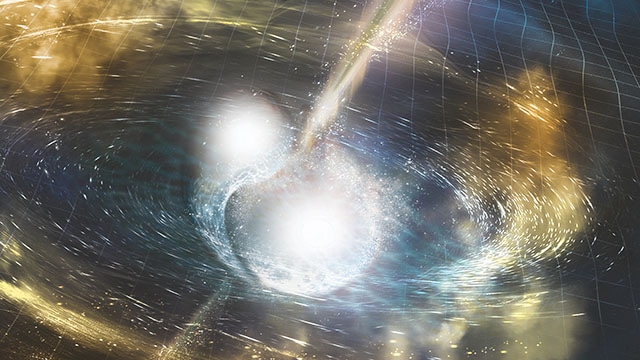Sep 10 2019
In 2017, an intense merger was observed between two neutron stars, and now the last chapter of that extraordinary detection has been officially written.
 An artistic rendering of two neutron stars merging. (Image credit: NSF/LIGO/Sonoma State/A. Simonnet)
An artistic rendering of two neutron stars merging. (Image credit: NSF/LIGO/Sonoma State/A. Simonnet)
When the intense bright burst eventually dimmed to black, an international team headed by Northwestern University meticulously built its afterglow—the last bit of the life cycle of the historic event.
To date, the ensuing image revealed the deepest picture of the afterglow of the neutron star collision. It also exposed the mysteries relating to the origins of the collision, the nature of shorter gamma-ray bursts, and the jet it produced.
This is the deepest exposure we have ever taken of this event in visible light. The deeper the image, the more information we can obtain.
Wen-fai Fong, Assistant Professor, Department of Physics and Astronomy, Weinberg College of Arts and Sciences, Northwestern University
The research will be reported this month in The Astrophysical Journal Letters. Fong, who headed the study, is also a member of Center for Interdisciplinary Exploration and Research in Astrophysics (CIERA)—an endowed research center at Northwestern University committed to progressing studies with a stress on interdisciplinary connections.
For a majority of the researchers, the 2017 neutron star merger, called GW170817, is the most significant discovery of the Laser Interferometer Gravitational-Wave Observatory (LIGO) to date. For the first time, astrophysicists successfully captured the collision between two neutron stars. Identified in both electromagnetic light and gravitational waves, the collision was also the first-ever multi-messenger observation between these two kinds of radiation.
The light emitted from GW170817 was partly identified because it was proximal, rendering it extremely bright and much easy to detect. Upon colliding, the neutron stars generated a kilonova—light that is 1000-fold brighter than a classical nova, occurring from the formation of heavy elements following the merger.
However, it was precisely this brightness that made its afterglow very difficult to determine. This afterglow is created when a jet travels almost at the speed of light and pummels the surrounding environment.
“For us to see the afterglow, the kilonova had to move out of the way,” Fong stated. “Surely enough, about 100 days after the merger, the kilonova had faded into oblivion, and the afterglow took over. The afterglow was so faint, however, leaving it to the most sensitive telescopes to capture it.”
Hubble to the Rescue
Beginning in December 2017, the Hubble Space Telescope from NASA spotted the visible light afterglow from the collision and again visited the collision’s location 10 more times over the duration of a year and a half.
Toward the end of March 2019, the Hubble Space Telescope was used by Fong team to obtain the last image and the deepest observation so far.
Over a period of seven-and-a-half hours, the Hubble recorded a picture of the sky from where the collision between the neutron stars took place. The ensuing image revealed—584 days following the merger of neutron stars—that the perceptible light radiated from the collision had finally faded.
Then, Fong’s group had to eliminate the brightness of the surrounding galaxy to isolate the very weak afterglow of the event.
To accurately measure the light from the afterglow, you have to take all the other light away. The biggest culprit is light contamination from the galaxy, which is extremely complicated in structure.
Peter Blanchard, Study Second Author and Postdoctoral Fellow, CIERA
Fong, Blanchard, and their colleagues used all the 10 images to deal with the challenge. In these images, the kilonova had faded and the afterglow remained, as did the final, deep Hubble image without any traces of the merger.
After overlaying the deep Hubble image on each of the 10 afterglow images, the researchers used an algorithm and carefully subtracted—pixel by pixel—all the light from the Hubble image from the previous afterglow images.
This resulted in an ultimate time-series of images, revealing the faint afterglow without the contamination of light from the background galaxy. Fully aligned with exemplary predictions, it is the most precise imaging time-series of GW170817’s visible-light afterglow generated so far.
“The brightness evolution perfectly matches our theoretical models of jets,” Fong added. “It also agrees perfectly with what the radio and X-rays are telling us.”
Illuminating Information
With the deep space image of the Hubble Telescope, Fong and her colleagues gained a new understanding of GW170817’s home galaxy. In addition, the researchers observed that the region around the collision was not thickly populated with star clusters, which might be the most incredible feature.
Previous studies have suggested that neutron star pairs can form and merge within the dense environment of a globular cluster. Our observations show that’s definitely not the case for this neutron star merger.
Wen-fai Fong, Assistant Professor, Department of Physics and Astronomy, Weinberg College of Arts and Sciences, Northwestern University
Based on the latest image, Fong also thinks that remote, cosmic explosions called short gamma-ray bursts are really neutron star mergers—simply observed from a different angle. Both create relativistic jets, which are just like a fire hose of material traveling almost at the speed of light.
Astrophysicists usually observe jets emerging from gamma-ray bursts when they are directly aimed, akin to staring directly into the fire hose. However, GW170817 was observed from a 30° angle, which had never been done before in the optical wavelength.
“GW170817 is the first time we have been able to see the jet ‘off-axis’,” Fong stated. “The new time-series indicates that the main difference between GW170817 and distant short gamma-ray bursts is the viewing angle.”
The study titled “The optical afterglow of GW170817: An off-axis structured jet and deep constraints on a globular cluster origin” was mainly supported by the National Science Foundation (award numbers AST-1814782 and AST-1909358) and NASA (award numbers HST-GO-15606.001-A and SAO-G09-20058A).